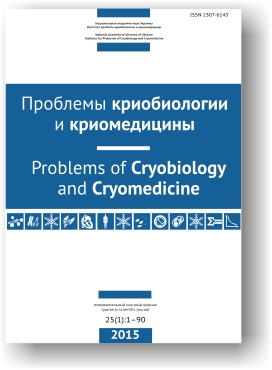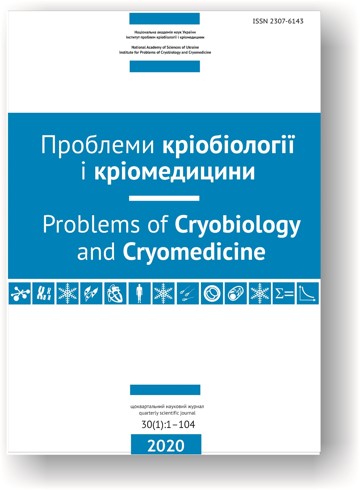Dehydration of mammalian erythrocytes affects their sensitivity to mechanical stress
DOI:
https://doi.org/10.15407/cryo25.01.024Keywords:
mammalian erythrocytes, dehydration, mechanical stress, potassium cations, hemolysisAbstract
Sensitivity of human, bovine, rat and equine erythrocytes to effect of mechanical stress in the media containing 0.15, 0.4 and 0.6 mol/l NaCl was studied. Mechanical stress of mammalian erythrocytes in the medium containing 0.15 mol/l NaCl results to the loss of K+ by cells: from 30% for equine erythrocytes and 60% for bovine cells. Bovine and equine erythrocytes in the medium, containing 0.15 mol/l NaCl show a maximum resistance on hemolysis index to mechanical stress effect. It has been shown that dehydration of human, bovine, rat, and equine erythrocytes in the media with 0.4 and 0.6 mol/l NaCl increases sensitivity of cells to mechanical stress. Bovine and rat erythrocytes are the most sensitive to an increase in osmotic load under mechanical stress on hemolytic damage index, and equine cells are the most sensitive to potassium ion outflux index. Different sensitivity of mammalian erythrocytes to mechanical stress under osmotic load is supposed to be determined by specific peculiarities of water transport and lipid composition of erythrocyte membranes. Comparative analysis of dehydration effect of erythrocytes on their resistance to stress factors showed that formation of stable state of cells (in the medium with 0.4 mol/l NaCl) to hypertonic shock effect did not provide their resistance under mechanical stress.
Probl Cryobiol Cryomed 2015; 25(1): 24-32.
References
Alexandrova D.I., Shpakova N.M. Effect of preliminary dehydration of human and bovine erythrocytes on cell resistance to hypertonic shock under different temperatures. Visnyk Problem Biolohiyi i Medytsyny 2007; 1: 73–77.
Benga G., Borza T. Diffusional water permeability of mammalian red blood cells. Comp Biochem Physiol B 1995; 112 (4): 653–659. CrossRef
Benga Gh., Matei H., Frentescu L. et al. Comparative nuclear magnetic resonance studies of diffusional water permeability of red blood cells from different species. XI. Horses introduced to Australia and European horses (Equus caballus). Comp Hematol Int 2000; 10: 138–143. CrossRef
Betticher D.C., Geiser J. Resistance of mammalian red blood cells of different size to hypertonic milieu. Comp Biochem Physiol A 1989; 93 (2): 429–432. CrossRef
Bogner P., Sipos K., Ludany A. et al. Steady-state volumes and metabolism-independent osmotic adaptation in mammalian erythrocytes. Eur Biophys J 2002; 31 (2): 145–152. CrossRef PubMed
Fedosova S.N., Kudokotseva E.V. Modifying action of curantyl on the osmotic susceptibility of red blood cells. Problems of Cryobiology 1995; (1): 27–31.
Goltsev A.N., editor. Current Problems of Cryobiology and Cryomedicine. Kharkov; 2012.
Ershov S.S., Orlova N.V., Shpakova N.M. Mammalian erythrocyte sensitivity to change in temperature and osmotic medium conditions. Problems of Cryobiology 2004; 3: 51–57.
Jones D.A. The importance of surface area/volume ratio to the rate of oxygen uptake by red cells. J Gen Physiol 1979; 74 (5): 643–646. CrossRef
Kondrahina I.P., editor. Methods of veterinary clinical laboratory diagnostics: a handbook. Moscow; 2004.
Kowluru R., Bitensky M.W., Kowluru A. et al. Reversible sodium pump defect and swelling in the diabetic rat erythrocyte: Effects on filterability and implications for microangiopathy. Proc Natl Acad Sci USA. 1989; 86 (9): 3327–3331. CrossRef PubMed
Matei H., Frentescu L., Benga Gh. Comparative studies of the protein composition of red blood cell membranes from eight mammalian species J Cell Mol Med 2000; 4 (4): 270–276. CrossRef PubMed
Miseta A., Bogner P., Berenyi E. et al. Relationship between cellular ATP, potassium, sodium and magnesium concentrations in mammalian and avian erythrocytes. Biochim Biophys Acta 1993; 1175 (2): 133–139. CrossRef
Pantaler E.R. Study of the resistance of dehydrated red blood cells to the effect of osmotic and mechanical stress. [dissertation]. Kharkiv; 1996.
Pozdnyakov V.V., Bondarenko V.A. The relationship between initial osmotic medium conditions and erythrocytes sensitivity to hypertonic stress in 4 M NaCl. Kriobiologiya 1989; 1: 47–49.
Sakota D., Sakamoto R., Sobajima N. et al. Mechanical damage of red blood cells by rotary pumps: selective destruction of aged red blood cells and subhemolytic trauma. Artif Organs 2008; 32 (10): 785–791. CrossRef PubMed
Shpakova N.M. Temperature and osmotic resistance of erythrocytes of different mammalian species. [dissertation]. Kharkiv; 2014.
Shpakova N.M., Orlova N.V., Alexandrova D.І., inventors.
Method of destruction of red blood cells. Patent of Ukraine
â„–52701, IPC 8G01N33/48. 2010 September 10.
Takahashi T., Noji S., Erbe E. F. et al. Cold shock hemolysis in human erythrocytes studied by spin probe method and freeze-fracture electron microscopy. Biophys J 1986; 49 (2): 403–410. CrossRef
Tan Y., Sun D., Wang J., Huang W. Mechanical characterization of human red blood cells under different osmotic conditions by robotic manipulation with optical tweezers. IEEE Transactions on biomedical engineering 2010; 57(7): 1816–1825. CrossRef PubMed
Wessels J.M.C., Veerkamp J.H. Some aspects of the osmotic lysis of erythrocytes III. Comparison of glycerol permeability and lipid composition of red blood cell membranes from eight mammalian species. Biochim. Biophys. Acta 1973; 291(1): 190–196. CrossRef
Downloads
Published
How to Cite
Issue
Section
License
Copyright (c) 2020 Nataliya M. Shpakova, Nataliya V. Orlova, Elena Ye. Nipot

This work is licensed under a Creative Commons Attribution 4.0 International License.
Authors who publish with this journal agree to the following terms:
- Authors retain copyright and grant the journal right of first publication with the work simultaneously licensed under a Creative Commons Attribution License that allows others to share the work with an acknowledgement of the work's authorship and initial publication in this journal.
- Authors are able to enter into separate, additional contractual arrangements for the non-exclusive distribution of the journal's published version of the work (e.g., post it to an institutional repository or publish it in a book), with an acknowledgement of its initial publication in this journal.
- Authors are permitted and encouraged to post their work online (e.g., in institutional repositories or on their website) prior to and during the submission process, as it can lead to productive exchanges, as well as earlier and greater citation of published work (See The Effect of Open Access).




